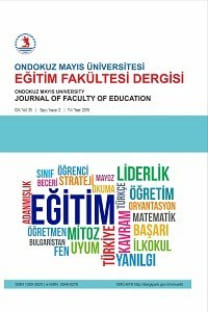Implementation of Middle School Mathematics Teachers’ Origami-Based Lessons and Their Views about Student Learning
constructivist-based teaching, learning types, middle school mathematics teachers, origami
___
- Arıcı, S. & Aslan-Tutak, F. (2015). The effect of origami-based instruction on spatial visualization, geometry achievement, and geometric reasoning. International Journal of Science and Mathematics Education, 13, 179-200.
- Boakes, N. J. (2006). The effects of origami lessons on students’ spatial visualization skills and achievement levels in a seventh-grade mathematics classroom. Unpublished doctoral dissertation, Temple University.
- Boakes, N. J. (2008). Origami-mathematics lessons: Paper folding as a teaching tool. Mathitudes, 1(1), 1-9.
- Boakes, N. J. (2009). Origami instruction in the middle school mathematics classroom: Its impact on spatial visualization and geometry knowledge of students. Research in Middle Level Education Online, 32(7), 1-12.
- Borg, W. R. & Gall, M. D. (1989). Educational Research. New York: Longman.
- Boulter, D. R. (1992). The effects of instruction on spatial ability and geometry performance. Unpublished master’s thesis. Queen’s University, Kingston, Ontario, Canada.
- Boyraz, S. (2008). The effects of computer based instruction on seventh grade students’ spatial ability, attitudes toward geometry, mathematics and technology. Unpublished master’s thesis. Middle East Technical University,Ankara, Turkey.
- Chen, K. (2006). Math in motion: origami math for students who are deaf and hard of hearing. Journal of Deaf Studies and Deaf Education, 11(2), 262-266. Cipra, B. A. (2001). In the Fold: Origami Meets Mathematics. SIAM News, 34 (8), 1-4.
- Coad, L. (2006). Paper folding in the middle school classroom and beyond. Australian Mathematics Teacher, 62(1), 6-13.
- Cakmak, S, Isiksal, M. & Koc, Y. (2014). Investigating effect of origami-based instruction on elementary students’ spatial skills and perceptions. The Journal of Educational Research, 107(1), 59-68.
- Demaine, E. (2004). Folding and Unfolding in Computational Geometry. http://courses.csail.mit.edu/6.885/fall04. Accessed at 24 March 2018.
- Fennema, E., & Franke, M. L. (1992). Teachers’ knowledge and its impact. In: Grouws DA (ed.). Handbook of research on mathematics teaching and learning. New York: Macmillian/NCTM.
- Gay, G. (2000). Culturally responsive teaching: Theory, research, and practice. New York: Teachers College Press.
- Graham, J. K. & Fennell, F. S. (2001). Principles and Standards for School Mathematics and Teacher Education: Preparing and Empowering Teachers. School Science and Mathematics, 101 (6), 319-327.
- Jones, A. (2010). Secondary school mathematics teachers’ views of manipulatives and their use in the classroom. M.A. thesis, University of Ottawa.
- Key, P. & Stillman, J. (2009). Teaching Primary Art and Design (Achieving QTS). Exeter:Learning Matters Ltd.
- Lang, R. (2001). Origami, Science and Applications. In T. Hull (ed.), Origami 3: Third International Meeting of Origami, Science, Mathematics, and Education, A. K. Peters, Canada.
- MacIsaac, D., & Falconer, K. (2001). Using the reform teacher observation protocol (RTOP) as a catalyst for self-reflective change in secondary science teaching. Paper presented at the meeting of the American Association of Physics Techers, Rochester, NY.
- Miura, K. (2001). The Application of Origami Science to Map and Atlas Design. In T. Hull (ed.), Origami 3: Third International Meeting of Origami, Science, Mathematics, and Education, A. K. Peters, Canada.
- Olkun, S. (2003). Making Connections: Improving Spatial Abilities with Engineering Drawing Activities. International Journal of Mathematics Teaching and Learning, 1-10.
- Stake, R. E. (1995). The art of case study research. Thousand Oaks, CA: Sage.
- Sze, S. (2005). Constructivism and the ancient art of origami. Proceeding of the Academy of Creativity and Innovation, Memphis, 2(1), 5-9.
- Temiz, T. & Topcu, M. S. (2014). Translation and validation of the Reformed Teaching Observation Protocol into Turkish. İlköğretim Online. 13 (3), 1122-1134.
- Tuğrul, B., & Kavici, M. (2002). Kağıt katlama sanatı ve öğrenme. Pamukkale Üniversitesi Eğitim Fakültesi Dergisi, 1(11).
- Turner-Bisset, R. (2001). Expert teaching: knowledge and pedagogy to lead the profession. London: David Fulton.
- Valentini, C. (2005). The Use of Origami in Primary EFL Teaching, http://www.lamaestra.it/origami/origami2.htm. Accessed at 17 May 2018.
- Wu, J. (2002). What is Origami?. http://www.origami.as/Info/intro.php. Accessed at 23 June 2018.
- Wu, J. (2006). Origami: A Brief History of the Ancient Art of Paper Folding, http://www.origami.as/Info/history.php. Accessed at 15 June 2018.
- ISSN: 1300-302X
- Yayın Aralığı: 2
- Başlangıç: 1986
- Yayıncı: Ondokuz Mayıs Üniversitesi Eğitim Fakültesi
Hakan Şevki AYVACI, Sinan BÜLBÜL, Kevser TÜRKER
Ayşe Gül ÖZAŞKIN ARSLAN, Sevilay KARAMUSTAFAOĞLU
Türkçe Öğrenenlerin Dinleme Başarısını Artırmak İçin Kullanılabilecek İki Farklı Uygulama
Sosyal Bilgileri Yerel Coğrafyaya İndirgemek: Şehrimiz … Dersi
MEB Okul Öncesi Eğitim Programının Anaakım Okul Öncesi Eğitim Programları Açısından İncelenmesi
Turan GÜLÇİÇEK, Funda Eda TONGA, Feyza TANTEKİN ERDEN
Tuğba ÇELİK, Arzu AYDOĞAN YENMEZ, Semirhan GÖKÇE
Yetişkinlerde Akılcı Olmayan İnançların Bazı Değişkenlere Göre İncelenmesi
